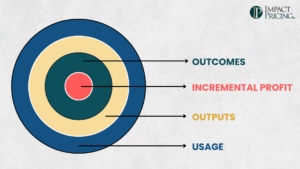You can listen to the full audio version of this blog we call — Blogcast.
The first indication that you need a new pricing metric is you have customers who get massive amounts of value but don’t pay you very much.
A pricing metric is what you charge for. It’s usually what goes on your invoice. Companies that sell physical goods typically charge by the item. Software and service companies have many options. You can charge by the click, download, storage, hour, month, project, and many, many more. The goal is to find a pricing metric where the customers pay more as they receive more value.
When a customer receives way more value than they pay for, you likely have a pricing metric problem. You are charging for the wrong factor.
One company sold a software tool to law firms and charged by the user. That metric worked well for smaller law firms because each lawyer who used the tool had a license. However, they identified some larger law firms that used the tool more but paid lower prices than many smaller firms. After looking into the reason, they found that larger firms hired a few assistants whose job was to use the tool for every lawyer. Since only the assistants needed a license, they bought fewer licenses than smaller firms. Hence, pricing by the user didn’t capture the value they delivered to large law firms.
The solution, of course, is to stop charging by the user and instead charge by something else, probably something related to usage of the tool.
Here is my recommendation. If you monitor the usage of your product (and you should if you are a cloud-based SaaS provider), take the overall price a customer pays and divide it by their usage. You now have a price per use. Do you see a huge range? Is there a point where the price per use jumps? If yes, investigate to see what is happening. It may be time to rethink your pricing metric.
If you can’t monitor usage, estimate how much value each customer receives. Compare that to how much they pay. If some customers receive much more value than they pay for, you may have the wrong pricing metric.
Buyers trade money for value. But when they get way more value than they pay for, you are doing something wrong. It’s likely an easy place to grow your revenue, margin, and profit.
What indicator do you use to revisit your pricing metric?
Share your comments on the LinkedIn post.
Now, go make an impact!
 Tags: pricing, pricing foundations, pricing metrics, pricing skills, pricing value, value-based pricing
Tags: pricing, pricing foundations, pricing metrics, pricing skills, pricing value, value-based pricing













